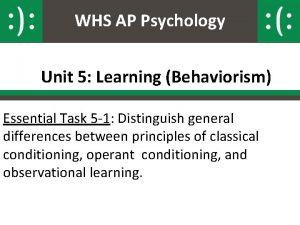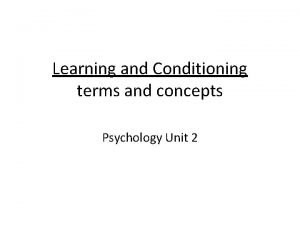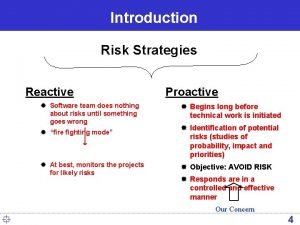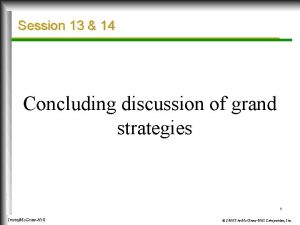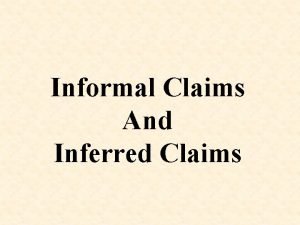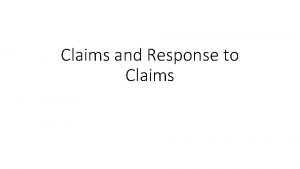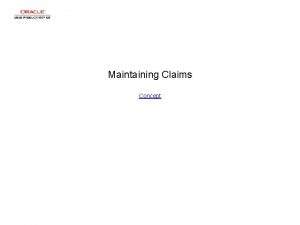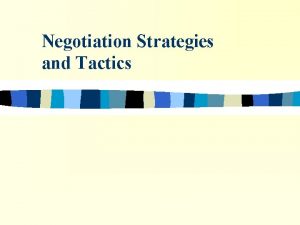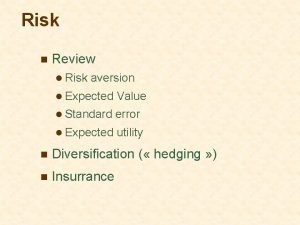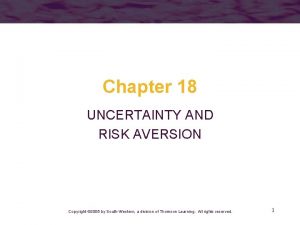Risk Aversion Negotiation and Claims Settlement Strategies Helen
























- Slides: 24

Risk Aversion, Negotiation, and Claims Settlement Strategies Helen Doerpinghaus University of South Carolina Joan Schmit University of Wisconsin Jason Jia-Hsing Yeh The Chinese University of Hong Kong 1

U. S. Auto Liability n Most widely owned major asset n 12. 5 M accidents for 21 M vehicles injuring 3 M people and killing 42, 000 (2001 data) n Factors affecting third-party liability – Fault – Extent of injury – State legal rules – Attorney involvement – etc. 2

Our purpose: To investigate how claimant risk aversion and negotiation costs affect third-party settlement 3

Model: Scenario Two-party accident. n A third-party claimant seeks BIL payment from the defendant driver’s insurer. n Based on the documented economic damages, the insurer offer x to settle. n The claimant may accept the offer or negotiate a higher settlement. How much would the claimant ask for? Let us call it y. n 4

Model: Claimant’s maximization n Negotiating for more is costly, claimant’s net payment: Higher expected net payment Higher utility n Volatility of the net payment disutility for risk-averse claimants n n So claimant’s expected utility: n Suppose the final payment is weighted average of y and x: 5

Model: Claimant’s maximization n The utility maximization requires: n The interior solution will be achieved only if n Otherwise, the boundary condition applies, so that y* = x 6

Figure 1: Claimant’s Utility and Optimal “Ask” 7

Model: Insurer’s cost minimization n Insurer’s choice of generosity factor is determined by minimization of two conflicting functions, the loss cost, and the admin cost: n The optimal g* is obtained from the first-order condition. n Let a(g) = g-1, for illustration of a closed-form solution for g*. 8

Figure 2: Insurer’s Optimal Generosity and Claimant’s Risk Aversion 9

Model: Claims Payment n With y* and g* obtained, we can insert them into the claims payment function: n Differentiating P* w. r. t. c and r, 10

We know Individual risk preferences differ With wealth Friend and Blume (1975, AER) Weber (1975, AER) Hansen and Singleton (1983, JPE) Mankiw (1985, REStats) Szpiro (1986, REStats) By sex Levin Snyder and Chapman (1988) Sorentino (1992) Powell and Ansic (1997) Jiankoplos and Bernasek (1998) Sunden and Surette (1998) Schubert (1999) Haleck and Eisenhauer (2001) By age Brown (1987) Riley and Chow (1992) Zuckerman (1994) Barsky et al. (1997) Haleck and Eisenhauer (2001) 11

We know • Risk-averse individuals are willing to pay more for insurance Cost Gain Cost 50% of losing $20, 000 Loss = $20, 000 with prob=50% An actuarially fair premium would be $10, 000!! 12

We know • Risk-averse individuals are willing to pay more for insurance WTP more than an actuarially fair premium!! We investigate • Whether risk preferences affect claiming behavior 13

We know Individual negotiating preferences differ By sex Stuhlmacher and Walters (1999) Graddy and Pistaferri (2000) By Age Fuchs (1982) Posner (1995) We investigate • Whether negotiation preferences affect claiming behavior 14

WHY do sex and age affect risk and negotiation preferences? Difficult to establish Theories biological differences cultural norms behavior values self-expectation time horizon for consumption physical or economic dependency 15

Given theory and empirics, We expect • Women and elderly are more risk-averse and have higher negotiation costs lower claims settlement amounts • Very young have less negotiation experience lower claims settlement amounts • Middle-aged have declining riskaversion and negotiating advantage (Haleck and Eisenhauer, 2001) 16

Data 1997 Insurance Research Council Claims included • Two cars • Claimant drives “other car” • Defendant drives insured car • Both at least 14 years old • Tort states without compulsory first-party coverage (“add on” states omitted) • 6573 observations Other data • U. S. Statistical Abstracts • U. S. Bureau of the Census 17

Model First, we estimate fault: Fi = + Di. D + Vi. V + Ci. C +ei Equation 1 Where Fi = insured defendant driver fault for the ith claim Di = a vector of defendant driver demographic characteristics of the ith claim D = a vector of regression coefficients for defendant driver demographic characteristics Vi = a vector of traffic violations for ith claim V = a vector of regression coefficients for traffic violations Ci = a vector of claim characteristics of the ith claim C = a vector of regression coefficients for claim characteristics ei = the random error term 18

Equation 1 Di demographics DFemale DMale Both. Male Age. Diff DYouthful DYMale DElderly + + Vi traffic violations DViolate CViolate DSevere CSevere + + - Ci claim characteristics Ln. Loss Strains Fatality Modified Attorney File Trial Verdict ? + + ? + 19

Second, we estimate claimant payment as a function of estimated fault. Pi = + Fi. F + Di. D + Si. S + Hi + Mi + ei Equation 2 where Pi = natural logarithm of total payment to claimant for the ith claim = intercept term = insured defendant driver fault (estimated above) for the ith claim F = a regression coefficient for claimant fault for the ith claim Di = measures of claimant risk aversion and negotiating characteristics D = a vector of regression coefficients for claimant risk aversion and negotiating characteristics Si = measures of claim severity S = a vector of regression coefficients for claim severity measures Hi = a vector of other claim characteristics associated with the ith claim = a vector of regression coefficients for claim characteristics Mi = a vector of state control variables for the ith claim = a vector of regression coefficients for the state control variables ei = the random error term 20

Equation 2 Di demographics CFemale CElderly CYouth CFYouth Si severity Ln. Wage. Loss Ln. Med. Loss Hosp 8 TDisable PDisable No. Injury Lacerat Fracture Disfigure Concuss Oth. Injury IME Neck Back Othr. Sprn Fatality ? + + + + 21

Equation 2 (continued) Hi claim characteristics Limit Attorney File Trial Verdict Unemp Metro + + ? ? Mi state controls Modified Metro. Pop Emp. Pop No. Hlth. Ins ? ? + 22

Conclusions Purpose: Investigate how differences in risk-aversion and negotiation preferences affect third-party insurance claims settlement Claims for similar injuries and fault assignments do not result in similar settlements: women and youthful claimants receive less women about 10 percent less than men youthful about 12 percent less than non-youthful no evidence of effect on elderly claimants 23

Results Consistent with literature on risk and negotiation preferences affecting other financial decisionmaking Consistent with markets working Not addressing discrimination per se 24
 Risk aversion indifference curve
Risk aversion indifference curve Helen midtown computer solutions helen speaking
Helen midtown computer solutions helen speaking Helen midtown computer solutions helen speaking
Helen midtown computer solutions helen speaking Endowment effect and loss aversion
Endowment effect and loss aversion You should not open a persuasive request with a question.
You should not open a persuasive request with a question. Liquidity measures
Liquidity measures Bargaining styles assessment tool
Bargaining styles assessment tool Behaviorism ap psychology
Behaviorism ap psychology Inequality aversion
Inequality aversion Pavlov types of conditioning
Pavlov types of conditioning Pavlov conditioning
Pavlov conditioning Ambiguity aversion bias
Ambiguity aversion bias Evaluation of aversion therapy
Evaluation of aversion therapy Aversion therapy evaluation
Aversion therapy evaluation Residual risk and secondary risk pmp
Residual risk and secondary risk pmp Business risk vs financial risk capital structure
Business risk vs financial risk capital structure Relative risk and attributable risk
Relative risk and attributable risk Relative risk
Relative risk Systematic attempt to specify threats to project plan
Systematic attempt to specify threats to project plan Risk reduction strategies for new entry exploitation
Risk reduction strategies for new entry exploitation Risk reduction strategies for new entry exploitation
Risk reduction strategies for new entry exploitation Which of the grand strategies is typically lowest in risk
Which of the grand strategies is typically lowest in risk Risk reduction strategies for new entry exploitation
Risk reduction strategies for new entry exploitation Risk projection in software engineering
Risk projection in software engineering Risk mitigation avoidance
Risk mitigation avoidance







